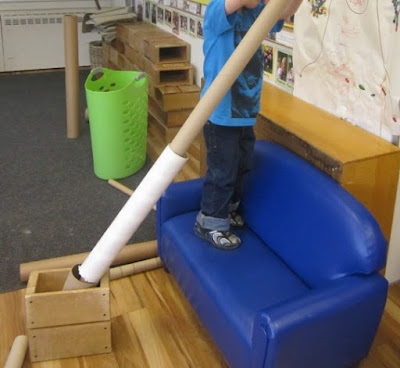Over the past few years, I’ve been learning more about the
Reggio Emilia philosophy of education. This summer, I attended an excellent
two-day workshop called “Revisiting the Environment for Young Children”, which
focused on creating meaningful learning environments in preschools.
One of the things that sometimes disappoints me about
discussing “Reggio” with other teachers, or looking for resources online, is
how quickly teachers zero in on the aesthetics of the environment and reduce
the entire discussion to decorating ideas. “Where did you but those wicker
baskets?” “Look at the ideas for paint storage I saw on Pinterest!” “I’m
throwing out everything made of plastic and switching to wood!” But Reggio is
more than decorating. A child centered, child focused, meaningful classroom
environment isn’t just about beautiful baskets, natural light, and the color of the walls. It’s about the essential view that teachers hold about
children.
It’s about viewing the child as competent.
Once we get past the beautiful, artistically arranged
environment of Reggio-inspired classrooms, we see the messages that the
environment is sending. The classroom environment is set up to support children’s
choices. The baskets full of items that can be easily spilled, and easily mixed
up send a message that the children are trusted to choose what they want to
use, how they want to use it, and to be able to put it away again. The fragile
fabrics, plants, lamps, and arrangements of natural materials send a message
that children can figure out how to move through this environment without
causing damage, or, that if things are broken or knocked down, the classroom
community is capable of repairing them.
The arrangement of tables, chairs, and materials and the
schedule of the day suggests that children are capable of managing their own
time, decisions, and movement through the physical space, but also through the
daily routine. I’ve so often heard teachers use phrases like “good classroom
management is putting out fires before they start”. Reggio-inspired
environments don’t view children as potential fire starters, or as objects to “manage”.
They assume that children are competent to make decisions, and that the teacher
is there to work alongside the children, not to stand above “managing” them.
As I set up my classroom for the new school year, thinking
about materials, routines, and rules, I’m well aware of the limitations of
young children. But instead of focusing on the many things that young children can’t do, or that aren’t safe, or that
might be frustrating to them, I’m creating an environment that supports what
they can do, as competent children
acting on the world around them.




No comments:
Post a Comment